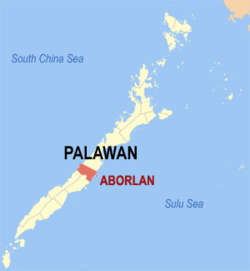Aborlan | |
|---|---|
| Municipality of Aborlan | |
 Palm plantation in Sagpangan, in Aborlan municipality | |
 Map of Palawan with Aborlan highlighted | |
Location within the Philippines | |
| Coordinates: 9°26′19″N118°32′53″E / 9.438639°N 118.548136°E | |
| Country | Philippines |
| Region | Mimaropa |
| Province | Palawan |
| District | 3rd district |
| Founded | June 28, 1949 |
| Barangays | 19 (see Barangays) |
| Government | |
| • Type | Sangguniang Bayan |
| • Mayor | Lito O. Tito |
| • Vice Mayor | Marvin C. Madeja |
| • Representative | Gil A. Acosta Jr. |
| • Municipal Council | Members |
| • Electorate | 28,433 voters (2025) |
| Area | |
• Total | 807.33 km2 (311.71 sq mi) |
| Elevation | 210 m (690 ft) |
| Highest elevation | 64 m (210 ft) |
| Lowest elevation | 0 m (0 ft) |
| Population (2024 census) [4] | |
• Total | 39,972 |
| • Density | 49.511/km2 (128.23/sq mi) |
| • Households | 9,715 |
| Economy | |
| • Income class | 1st municipal income class |
| • Poverty incidence | 15.44 |
| • Revenue | ₱ 446.1 million (2022) |
| • Assets | ₱ 1,119 million (2022) |
| • Expenditure | ₱ 260.1 million (2022) |
| • Liabilities | ₱ 228.9 million (2022) |
| Service provider | |
| • Electricity | Palawan Electric Cooperative (PALECO) |
| Time zone | UTC+8 (PST) |
| ZIP code | 5302 |
| PSGC | |
| IDD : area code | +63 (0)48 |
| Native languages | Aborlan Tagbanwa Palawano Tagalog |
Aborlan, officially the Municipality of Aborlan (Tagalog : Bayan ng Aborlan), is a municipality in the province of Palawan , Philippines. According to the 2020 census, it has a population of 38,736 people. [6]
Contents
- Etymology
- History
- Legend
- American era
- World War II
- Post-war independence
- Geography
- Barangays
- Climate
- Demographics
- Economy
- Culture
- Education
- Primary and elementary schools
- Secondary schools
- Higher educational institution
- References
- External links
Aborlan is the province's only town with an agricultural college, now called Western Philippines University. It was founded in 1910. [7]


